Mineral Feeding for Healthy Cows
Minerals and Vitamins are Important for Healthy and Profitable Dairy Cows
Feeding the proper amounts of each mineral and vitamin is essential for the health, growth, reproduction, and optimum milk production of dairy cattle. Feeding less than the optimum amount of any mineral or vitamin can result in an increased incidence of disease and reproductive problems, lower milk production, and decreased growth rate in heifers; all of which can potentially decrease the profitability of a dairy operation. To prevent these costly problems, the proper amounts of each required mineral and vitamin must be supplied and actually consumed by all dairy cattle, including not only the milking cows, but also dry cows and heifers.
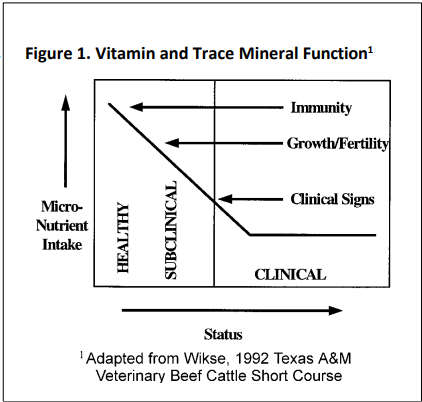 Nutritionists continue to investigate the role of various minerals and vitamins in preventing disease as well as enhancing reproductive performance. Research has suggested that slight deficiencies of certain trace minerals may detrimentally affect a cow's immune function and her natural ability to fight off infections, such as mastitis and other diseases, and impact the response to vaccines which can prevent or minimize the severity of a disease. A decrease in immune function may be seen before decreases in milk production or severe deficiency symptoms, such as change in hair coat color or skin lesions (figure 1). Thus, close attention to your herd's mineral needs is very important. Figure 2 lists the trace minerals and vitamins which are currently believed to be the most important in optimizing disease resistance in dairy cattle. Some scientists would also add chromium to this listing.
Nutritionists continue to investigate the role of various minerals and vitamins in preventing disease as well as enhancing reproductive performance. Research has suggested that slight deficiencies of certain trace minerals may detrimentally affect a cow's immune function and her natural ability to fight off infections, such as mastitis and other diseases, and impact the response to vaccines which can prevent or minimize the severity of a disease. A decrease in immune function may be seen before decreases in milk production or severe deficiency symptoms, such as change in hair coat color or skin lesions (figure 1). Thus, close attention to your herd's mineral needs is very important. Figure 2 lists the trace minerals and vitamins which are currently believed to be the most important in optimizing disease resistance in dairy cattle. Some scientists would also add chromium to this listing.
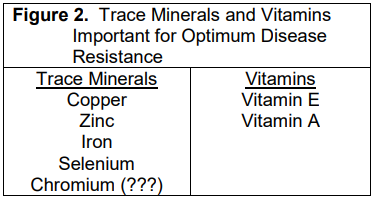
Means of Supplementing Minerals and Vitamins
Ideally, supplemental minerals and vitamins should be added in the recommended amounts to the grain mix or total mixed ration. This feeding scheme regulates the intake of each mineral and vitamin so that each cow or heifer receives the expected amount. Research has shown that cattle do not consume the correct amounts when minerals or vitamins are fed separately in a mineral feeder. Thus, by adding them to the in a grain mix or TMR, heifers, dry cows and milking cows receive the expected amount of each mineral and vitamin supplemented.
Heifers and dry cows can be fed free-choice mineral supplements where salt is used to regulate the intake of the mineral/vitamin supplement. Cattle will consume salt to meet their needs (the only “mineral” which is consumed to meet needs.) However, the intake of mineral/vitamin supplement has been shown to be highly variability with intake varying between animals and from day-to-day. Thus, whenever possible the correct amount of mineral should be included in the grain mix or TMR.
Many trace mineralized salts do not supply adequate amounts of the trace minerals needed by heifers and dry or milking dairy cows. They often do not contain selenium or vitamins A, D, or E or they may be found but in inadequate amounts. Thus, trace mineralized salt should not be used to supply trace minerals or vitamins. When looking at a feed recipe, make sure to differentiate between trace mineralized salt and a trace mineral premix. Trace mineral premixes are used by many feed mills and often times provide an adequate amount of trace minerals and/or vitamins when added at the proper rate for a heifer, dry cow or milk cow grain mix or total mixed ration.
Evaluating Your Mineral Program
Mineral feed tags for dairy cattle are required to list the concentration of calcium, phosphorus, salt, magnesium, potassium, selenium, and vitamin A. They are not required to list the concentration of the other required trace minerals or vitamins. Thus, when evaluating a mineral to see if it supplies the trace minerals and vitamins needed, the first step is to check the feed tag for a source of the trace minerals and vitamins listed in figure 3. These minerals and vitamins can be found in the listing of the ingredients on a mineral feed tag. The ingredients are generally listed in the decreasing amount added. Finding these minerals in the listing says that these have been added, but does not indicate how much of each will be supplied by the grain or mineral mix. Often times, this information will be supplied by the manufacturer upon request. This information along with the mineral content of the forages being fed can be used to see if your dairy heifers or cows are receiving the proper amount of each mineral. Collecting representative samples of forages currently being fed and then analyzing these samples by a forage testing lab using wet chemistry methods of analysis can help troubleshoot if deficiencies or excess are being fed. The total amount of various trace minerals and fat-soluble vitamins to be added to the total diet (forages and concentrates) for milking and dry cows can be found in the latest “Nutrient Requirements for Dairy Cattle” publication (example in Table 1).
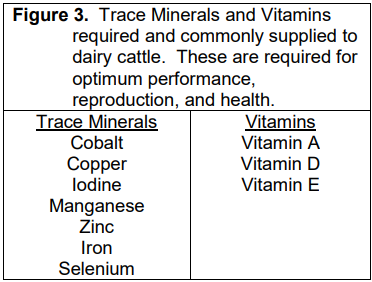
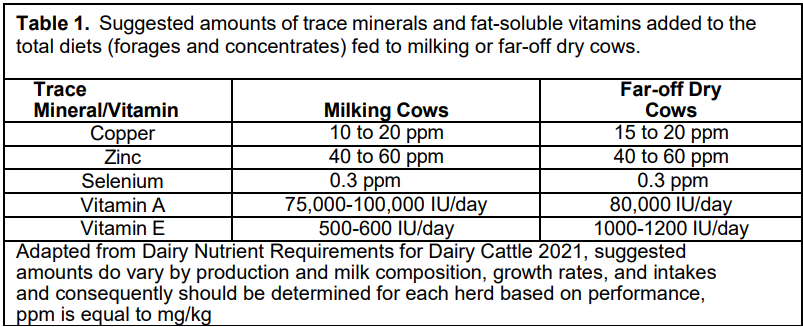
The old adage, “A little is good, more must be better” does not apply when supplementing minerals and vitamins. The amount of one mineral affects the absorption of other minerals, which are just as essential. Thus, each trace mineral must be added in the correct amount and in an amount which is relative to all other minerals. For example, excess amounts of iron, sulfur, or molybdenum in the water and/or feed will reduce the amount of copper and zinc absorbed by cattle. Thus, when deficiencies are suggested by blood or liver tissue analysis, the feeds and water supply need to be evaluated by a highly-trained nutritionist and a nutritional plan devised to correct the deficiency if necessary.
Generally, supplemental trace minerals are supplied through inorganic sources. These inorganic sources generally are in the form of sulfates, phosphates, chlorides, carbonates, or oxide forms of the trace mineral. Research has shown that some inorganic sources of trace minerals are more available than others. For example, sulfates are generally more available than the oxide forms of the trace mineral. As an example, research has shown that copper oxide does not provide adequate copper to dairy or beef cattle as well as pigs and chickens. Iron oxide is used to color mineral mixes red, but provides very little nutritional value and decreases the availability of other trace minerals, such as copper. Table 2 lists the different sources of each of the trace minerals. Also listed are the relative bioavailability of the trace mineral for each of the sources listed.
Organic minerals are often classified as chelates or proteinates. These trace elements are bound to amino acids or pieces of protein. They are absorbed in the intestines by a different mechanism which increases their bioavailability and makes them particularly useful in situations where other minerals decrease the availability of a particular mineral. Generally, organic minerals are added to supply 25 to 50% of the amount needed of a given trace mineral.
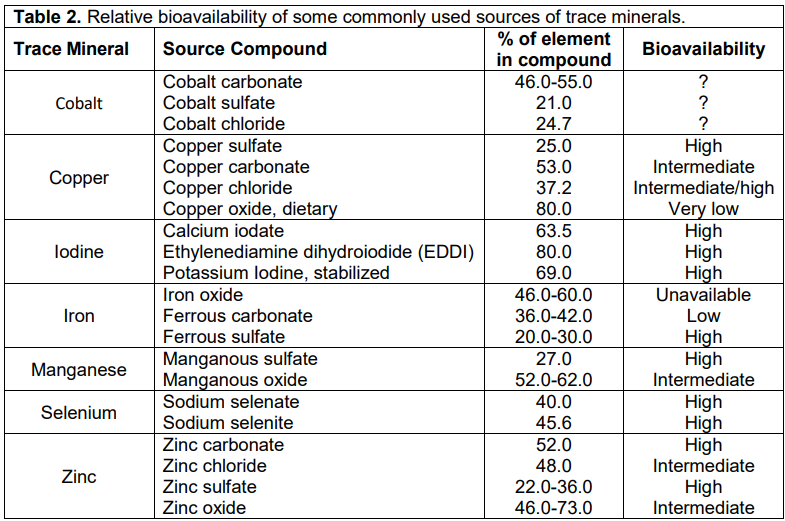
Bottom Line
Feeding the proper amount of all minerals and vitamins is important for profitable milk production from healthy cows. To accomplish this objective, take time to review your current mineral/vitamin feeding program. Items to review include:
- All minerals and vitamins should be included in the grain mix whenever possible.
- If you mix your own feed, add the correct number of bags or amount of mineral mix to the grain mix or TMR. If the appropriate amount of mineral is not added, performance and disease resistance of your heifers, dry cows, and milking cows may be compromised. When adding minerals to a TMR, make sure that the mineral gets dispersed and mixed evenly throughout the TMR mixture.
- If dry cows and heifers are fed free-choice mineral, make sure they always have mineral available. Grain mixes formulated for milking cows and then fed to bred heifers and dry cows do not contain enough trace minerals and vitamins. To provide heifers and dry cows the proper amounts of each minerals and vitamins, a grain mix must be formulated with their needs in mind.
- Trace mineralized salt often does not provide adequate amounts of minerals and vitamins. Complete mineral mixes are necessary to provide adequate amounts of minerals and vitamins.
- If you are feeding a commercial grain mix or protein supplement to the milking herd, check the ingredient listing and make sure it contains all of the needed minerals and vitamins. Feed tags are required to list the concentration of calcium, phosphorus, and selenium. Pelleted grain mixes with 16 to 20% crude protein can contain at least 0.9% calcium and 0.6 ppm of selenium. High protein supplements should contain more calcium and selenium.
- If you want to review your current feeding program, contact your local extension agricultural agent and we can help you interpret if your cows and heifers are getting the appropriate amount of trace minerals and vitamins.
Author: Donna Amaral-Phillips
